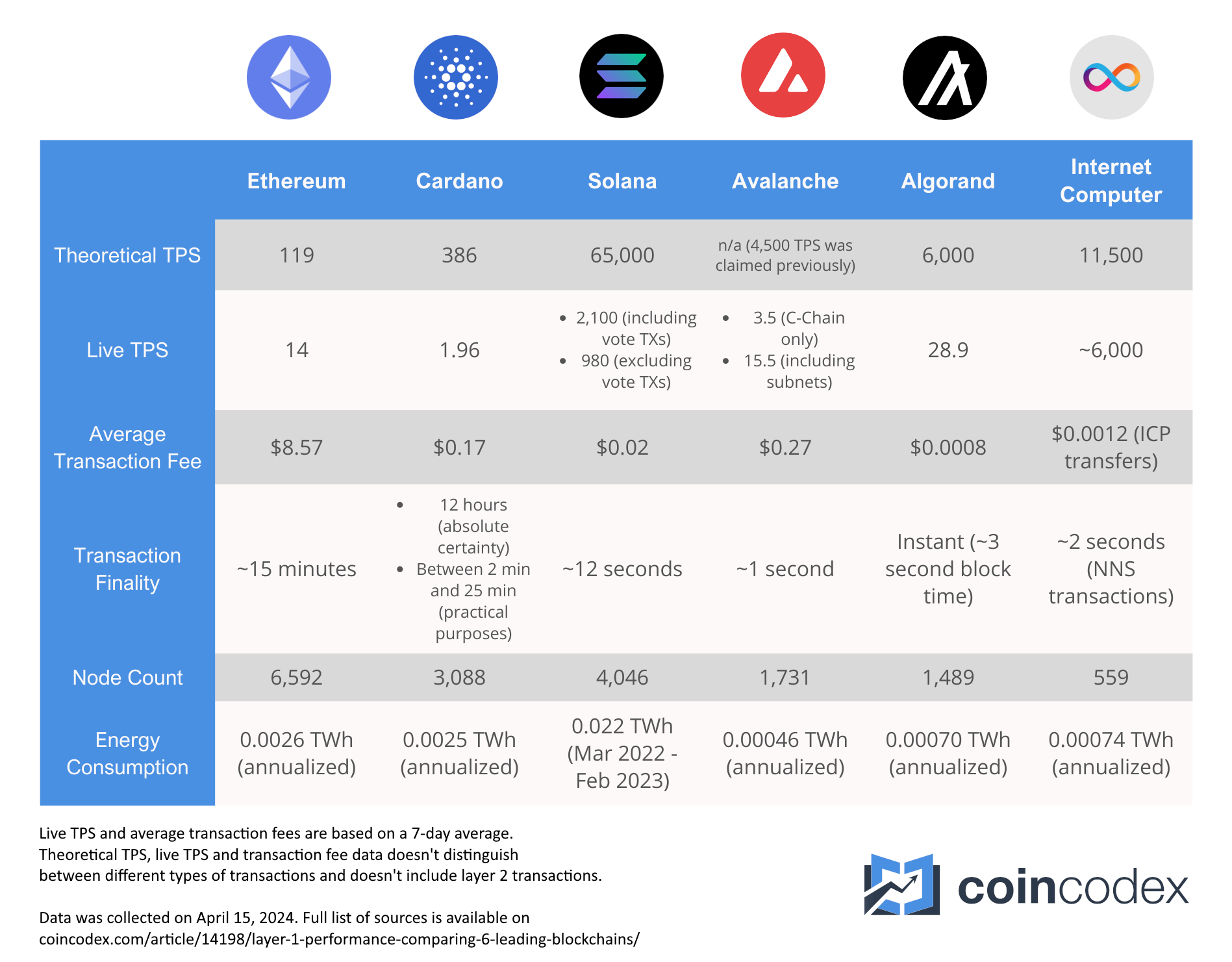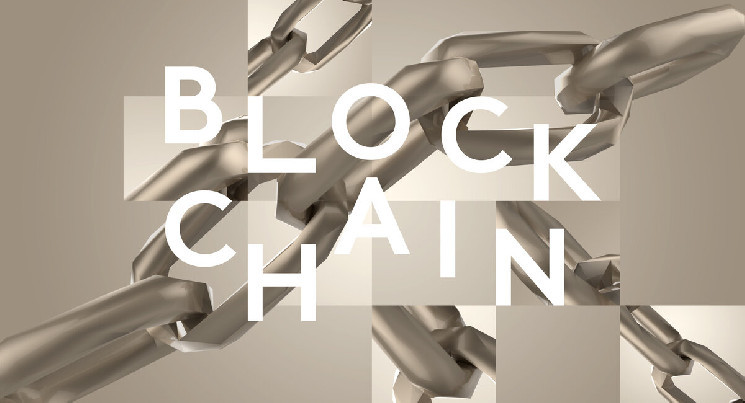We offer a layer 1 blockchain efficiency comparability of 6 main blockchain platforms: Ethereum, Cardano, Solana, Avalanche, Algorand and Web Pc.
Earlier than we start with our comparability, it’s vital to spotlight that scaling on layer 1 is just not the one approach to enhance the scalability of blockchains. Tasks comparable to Ethereum and Cardano are focusing lots of consideration on scaling by layer 2 options that may deal with a bigger variety of transactions whereas leveraging the safety of the underlying layer 1.
On this article, we saved comparisons restricted to layer 1 efficiency, but it surely’s price maintaining in thoughts that it doesn’t inform the entire story – for instance, Ethereum customers are already benefiting considerably from layer 2 options comparable to Arbitrum, Optimism and Base, and layer 2 applied sciences are steadily bettering and gaining adoption.
On the backside of the article, we offer a full listing of sources used to make this comparability.

Evaluating the layer 1 efficiency of 6 main blockchains
Essentially the most simple solution to evaluate the efficiency of blockchains is to take a look at what number of transactions a blockchain is able to processing inside a given time interval. The most typical metric used for this function is TPS (transactions per second).
One other vital facet to contemplate is a blockchain’s time to finality. This metric refers to how lengthy it takes for a transaction to be thought of irreversibly settled on the blockchain. There may be lots of nuance to the topic of blockchain finality (in lots of blockchains, what’s thought of as “remaining” is as much as interpretation), however we’ve made our greatest efforts to search out generally accepted time to finality figures for every of the blockchains we’re evaluating.
Ethereum
Ethereum can deal with 119 TPS in idea on layer 1, though the community is unlikely to ever method this determine, as it will require a really particular set of circumstances (for instance, all transactions being normal ETH transfers).
In follow, the Ethereum community is dealing with about 14 transactions per second on layer 1. The demand for transacting on the Ethereum blockchain is immense – in keeping with cryptofees.information, Ethereum customers are presently paying about $9.6 million in complete charges day-after-day.
Ethereum transactions are thought of remaining after a interval of roughly quarter-hour, which corresponds to 2 epochs (an epoch is a interval of 32 slots through which validators suggest blocks and attest to blocks). Ethereum’s roadmap features a idea known as Single Slot Finality (SSF), which would cut back the time to finality to mere seconds.
Cardano
Cardano’s present theoretical TPS restrict is at round 386 TPS. The Cardano blockchain is processing roughly 2 TPS on common on the time of writing this text, though it does have fairly a little bit of headroom to deal with a spike in demand for transactions.
The Cardano venture can be engaged on numerous options comparable to sidechains and layer 2s to dramatically enhance scalability. In all probability probably the most notable growth right here is the Hydra layer 2 scalability answer.
In relation to Cardano’s time to finality, there’s fairly a little bit of nuance. The Ouroboros Proof-of-Stake consensus protocol ensures finality after 2,160 blocks, which takes roughly 12 hours.
In most sensible situations, nevertheless, this diploma of finality is just not required earlier than a transaction could be thought of as settled. In sensible situations, Cardano transactions could be thought of remaining in between 2 and 25 minutes. How lengthy to attend earlier than contemplating a transaction as remaining in the end depends upon the importance of the transaction to the transacting events.
Solana
Solana is a blockchain venture that’s primarily centered on layer 1 enhancements to spice up scalability. Solana is already very performant when in comparison with most different blockchains available on the market in the present day. In testing circumstances, Solana has demonstrated the potential of dealing with round 65,000 transactions per second.
At the moment, the Solana blockchain is processing simply over 2,000 transactions per second on common. Nevertheless, this metric additionally consists of vote transactions, which some don’t take into account as “actual” transactions. If we exclude these transactions, Solana is processing slightly below 1,000 transactions per second on common in real-world circumstances.
So far as scalability enhancements are involved, the Solana group is trying ahead to the upcoming mainnet launch of Firedancer, a extremely performant Solana consumer that’s being developed by Leap Crypto. Attributable to its effectivity, Firedancer is poised to make Solana even sooner and extra cost-efficient as a layer 1 blockchain.
On Solana, transactions are thought of remaining after 31 block confirmations, which generally takes about 12 seconds.
Avalanche
Now we have beforehand been capable of finding claims of 4,500 theoretical TPS on numerous supplies on the official Avalanche web site, however the venture doesn’t look like claiming 4,500 theoretical TPS anymore in its official supplies. As of April 2024, we have been unable to discover a good benchmark for what number of transactions Avalanche can deal with in idea.
Transferring on to follow, Avalanche is presently processing roughly 3.5 TPS if we solely rely the C-Chain, which is the chain within the Avalanche community that’s tasked with dealing with EVM-compatible sensible contracts. If we additionally embrace Avalanche’s numerous subnets into the equation, the Avalanche community is processing roughly 15.5 transactions per second.
Avalanche’s Proof-of-Stake consensus protocol excels when it comes to time to finality, as transactions on Avalanche obtain finality in roughly one second.
Algorand
The Algorand blockchain can deal with round 6,000 TPS in idea following the three.9 improve, which elevated the block dimension to five MiB and diminished block latency to below 4 seconds. The venture claims it has a key efficiency purpose of attaining 10,000 TPS, which can primarily be finished by lowering spherical occasions.
In follow, the Algorand blockchain is dealing with slightly below 30 transactions per second, with customers solely paying about $0.0008 in charges per transaction on common.
The design of the Algorand blockchain permits it to attain “immediate” finality, though that is restricted in follow by the block time. At the moment, Algorand is including blocks to the chain about each 3 seconds, which could be thought of because the time to finality for a transaction on Algorand.
Equally to Solana, the Algorand venture’s scalability roadmap is primarily centered on enhancements to layer 1 as an alternative of counting on layer 2 scalability options.
Web Pc
In its present configuration, the Web Pc platform can deal with about 11,500 TPS in idea. In follow, the Web Pc is dealing with roughly 6,000 TPS on the time of writing this text.
Transactions on the Web Pc platform have quick finality – subnets devoted to decentralized purposes can obtain finality in about 1 seconds, whereas the finality for NNS (Community Nervous System) transactions is about 2 seconds.
Though charges on the community range based mostly on the operation the consumer is making an attempt to carry out, sending the community’s native asset ICP solely prices about $0.0012 on common.
Whereas Web Pc offers spectacular scalability when in comparison with most blockchains, it’s vital to needless to say the Web Pc makes fairly a couple of tradeoffs between decentralization and efficiency. For instance, becoming a member of the community as a validator requires permission. In the meantime, all the opposite blockchains now we have featured on this article are permissionless.
The underside line
Our intention was to supply a baseline comparability between main blockchains and to not decide which blockchain is the “finest”. Hopefully, our layer 1 blockchain efficiency comparability has helped you resolve which L1 community is finest in your wants. Whereas scaling is a really complicated matter, we centered on traits like transaction pace, finality, scalability, node rely and power effectivity, that are among the many commonest metrics used to measure blockchain efficiency.
It’s vital to grasp completely different blockchains are designed with an emphasis on completely different traits, so direct comparisons between chains shouldn’t be finished with out context.
For instance, if a blockchain sacrifices some decentralization with a purpose to enhance its transaction throughput, it will be unfair to label it as “higher” or “worse” than a blockchain which is extra decentralized however not as performant.
In the end, will probably be attention-grabbing to look past the efficiency metrics to see what the long run holds in retailer for every of the blockchain networks mentioned above.
Within the meantime, you possibly can examine our number of the most affordable cryptocurrency networks for transfers, which let you save on transaction prices and have interaction with DeFi and NFT services at an accessible price.
Sources
Listed below are the sources we used to reach on the knowledge factors utilized in our blockchain layer 1 efficiency comparability.
Ethereum
- Theoretical TPS: https://www.kiln.fi/publish/path-to-proto-danksharding-episode-i-ethereum-scalability-limitations
- Dwell TPS: https://chainspect.app/chain/ethereum?vary=7d
- Common transaction price:
- https://www.theblock.co/knowledge/on-chain-metrics/ethereum/average-transaction-fee-on-ethereum
- Finality: https://ethereum.org/en/roadmap/single-slot-finality/
- Ethernodes: https://www.ethernodes.org/
- Vitality effectivity: https://ethereum.org/en/energy-consumption/
Cardano
- Theoretical TPS: https://eutxo.org/stats/information
- Dwell TPS: https://cexplorer.io/tps
- Common transaction price: https://messari.io/venture/cardano/charts/fees-and-revenue/chart/txn-fee-avg-ntv
- Vitality effectivity: https://cexplorer.io/power
- Transaction finality: https://twitter.com/_KtorZ_/standing/1482346836992180224
- https://cexplorer.io/article/understanding-transaction-finality
- Node rely: https://adapools.org/
Solana
- Theoretical TPS: https://solana.com/information/network-performance-report-july-2023
- Dwell TPS: https://chainspect.app/chain/solana?vary=7d
- Common transaction price: https://solanacompass.com/statistics/charges
- Transaction finality: https://www.tbstat.com/wp/uploads/2022/02/20220222_FinalityReport_TheBlockResearch.pdf
- Node rely: https://solanacompass.com/statistics/decentralization
- Vitality consumption: https://solanaclimate.com/
Avalanche
- Dwell TPS: https://snowtrace.io/chart/tps
- Common transaction price: https://dune.com/queries/1389077/2361423
- Transaction finality: https://www.avax.community/weblog/time-to-finality-ttf-the-ultimate-metric-for-blockchain-speed
- Node rely: https://subnets.avax.community/
- Vitality consumption: https://www.avax.community/weblog/ccri-report-2023
Algorand
- Theoretical TPS: https://developer.algorand.org/articles/algorand-boosts-performance-5x-in-latest-upgrade/
- Dwell TPS, Common transaction price: https://metrics.algorand.org/#/protocol/#transactions
- Transaction finality: https://metrics.algorand.org/#/protocol/#blocks
- Node rely: https://metrics.algorand.org/
- Vitality consumption: https://twitter.com/JohnAlanWoods/standing/1628781089853415424
Web Pc
- Theoretical TPS: https://medium.com/dfinity/the-internet-computers-transaction-speed-and-finality-outpace-other-l1-blockchains-8e7d25e4b2ef
- Dwell TPS, common transaction price: https://dashboard.internetcomputer.org/
- Node rely: https://www.icpexplorer.org/#/datacenters
- Transaction finality: https://internetcomputer.org/docs/present/developer-docs/multi-chain/faq/cketh-faq
- Vitality consumption: https://medium.com/dfinity/internet-computer-footprint-assessing-ic-energy-consumption-and-sustainability-4a4dcf10707a



